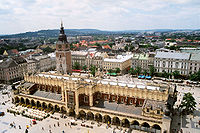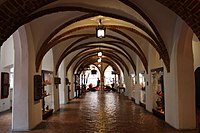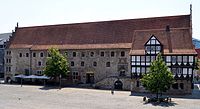Cloth hall
A cloth hall or linen hall (German: Gewandhaus; Polish: Sukiennice; French: Halle aux draps; Dutch: Lakenhal) is a historic building located in the centre of the main marketplace of a European town. Cloth halls were built from medieval times into the 18th century.
A cloth hall contained trading stalls for the sale, particularly, of cloth but also of leather, wax, salt, and exotic imports such as silks and spices.
Poland[]
In Poland, the most famous existing cloth-hall building is Kraków's Cloth Hall (Sukiennice), rebuilt in 1555 in Renaissance style.[1] The 14th-century Gothic cloth hall in Toruń is preserved as part of the Old Town Market Hall.
Cloth halls formerly also existed in Poznań, at the Old Market Square; and in Wrocław, at the site of the street now called ulica Sukiennice (Cloth-Hall Street).
Germany[]
Examples of German Gewandhäuser can be found in the towns of Brunswick, Zwickau, and Leipzig.
The rebuilt, third Leipzig Gewandhaus is home to the Leipzig Gewandhaus Orchestra.
Gewandhaus (Cloth Hall) in Brunswick, Germany

Gewandhaus (Cloth Hall) in Zwickau, Germany

Rebuilt, third Leipzig Gewandhaus concert hall (opened 1981)
Belgium and Netherlands[]
The former Cloth Hall in Leiden, Holland, has, since the 19th century, housed the Stedelijk Museum De Lakenhal (Municipal Cloth-Hall Museum) of art.
Examples of cloth halls in Belgium include the Ypres Cloth Hall and cloth halls in Bruges, Leuven, and Tournai. Leuven's Linen-Hall is in an early-Gothic style, with baroque addition, and now serves as the Leuven University Hall.

Leiden (Holland) Broadcloth Hall: 19th-century view of present-day Museum De Lakenhal (Cloth-Hall Museum) of art
Britain and Ireland[]
British examples are Drapers' Hall, London; the Piece Hall, Halifax; and Leeds' White Cloth Hall.

Piece Hall (cloth hall), Halifax, England
Surviving part of Leeds' 3rd White Cloth Hall (opened 1775)
In Ireland, the Dublin Linen Hall was completed in 1728, and later White Linen Hall was constructed in Belfast,[2] and there were linen halls in other towns such as Castlebar and Clonakilty.
Notes and references[]
| Wikimedia Commons has media related to Cloth halls. |
- ^ The World's Best Squares, PPS website, Making Places, December 2005
- ^ Hopkins, Frank (4 September 2008). "The Very Fabric Of Dublin's Past". Irish Independent. Retrieved 31 August 2021.
- Commercial buildings









